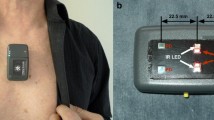Abstract
We attempted to evaluate prospectively local thermoregulatory vasoconstriction and vasodilatation in 15 volunteers by means of pulse oximetry and plethysmography as measured by a finger tip-pulse oximeter. Recent studies [1] concluded that the plethysmo time interval (PTI) between the QRS complex on ECG and the upstroke of the Plethysmographic wave of the pulse oximeter is useful in evaluating the peripheral circulatory status. Venous (both Vv cubitae) blood samples for determination of SvO2 were drawn, as well as pulse oximetry SpO2 oxygen saturation measurements and calculation of PTI were performed under conditions of normothermia, hypothermia and hyperthermia, before and after immersing the hands of the volunteers in a cold (15 °C) and warm (45 °C) waterbath. Two pulse oximeters simultaneously were used, one for each hand, in order to check to which extent SpO2, SvO2 and PTI might be influenced by gross limb temperature changes. Our results show that during local hyperthermia SpO2 significantly decreased and during local hypothermia SpO2 increased after immersing the one hand in a warm waterbath and the other hand in a cold waterbath at the same time. The peripheral SvO2 significantly increased in the warm hand and decreased in the cold hand. PTI remained unchanged after exposure to either a cold or a warm waterbath. The possibility of technical causes for the SpO2 changes were eliminated. Finger-tip pulse oximetry SpO2 readings change with limb temperature. The change in venous oxygen saturation can be explained by temperature dependent arteriovenous shunts in the periphery. The observed change in SpO2 probably reflects altered transmission of arterial pulsations to venous blood in the finger.
Similar content being viewed by others
References
Oishi M, Nishida H, Kabe K, Hoshi J. Monitoring neonatal peripheral circulation by electrocardiogram-to-oximeter pulse velocity. Pediatr Res 1993; 33: 653–657
Taylor MB, Whitwam JG. The accuracy of pulse oximeters. A comparative clinical evaluation of five pulse oximeters. Anaesthesia 1988; 43: 229–232
Clayton DG, Webb RK, Ralston AC, Duthie D, Runciman WB. A comparison of the performance of 20 pulse oximeters under conditions of poor perfusion. Anaesthesia 1991; 46: 3–10
Hahn M, Shore AC. The effect of rapid local cooling on human finger nailfold capillary blood pressure and blood cell velocity. J Physiol Lond 1994; 478: 109–114
Hynson JM, Sessler DI, Belani K, Washington D, McGuire J, Merrifield B et al. Thermoregulatory vasoconstriction during propofol/nitrous oxide anesthesia in humans: threshold and oxyhemoglobin saturation. Anesth Analg 1992; 75: 947–952
Palve H. Comparison of reflection and transmission pulse oximetry after open-heart surgery. Crit Care Med 1992; 20: 48–51
Palve H, Vuori A. Accuracy of three pulse oximeters at low cardiac index and peripheral temperature. Crit Care Med 1991; 19: 560–562
al Khudhairi D, Prabhu R, el Sharkawy M, Burties R. Evaluation of a pulse oximeter during profound hypothermia. An assessment of the Biox 3700 during induction of hypothermia before cardiac surgery in paediatric patients. Int J Clin Monit Comput 1990; 7: 217–222
Gabrielczyk MR, Buist RJ. Pulse oximetry and postoperative hypothermia. An evaluation of the Nellcor N-100 in a cardiac surgical intensive care unit. Anaesthesia 1988; 43: 402–404
Thys DM, Cohen E, Girard D, Kirschner PA, Kaplan JA. The pulse oximeter: a non-invasive monitor of oxygenation during thoracic surgery. Thorac Cardiovasc Surg 1986; 34: 380–383
Sami HM, Kleinman BS, Lonchyna VA. Central venous pulsations associated with a falsely low oxygen saturation measured by pulse oximetry. J Clin Monit 1991; 7: 309–312
Hewlett Packard. Parameter Information for Customer Engineers. HP Customer Information 1991
Reynolds KJ, de Kock JP, Tarassenko L, Moyle JT. Temperature dependence of led and its theoretical effect on pulse oximetry. Br J Anaesth 1991; 67: 638–643
Broome IJ, Mills GH, Spiers P, Reilly CS. An evaluation of the effect of vasodilatation on oxygen saturations measured by pulse oximetry and venous blood gas analysis. Anaesthesia 1993; 48: 415–416
Kelleher JF, Ruff RH. The penumbra effect: vasomotion-dependent pulse oximeter artifact due to probe malposition. Anesthesiology 1989; 71: 787–791
Hales JR. Skin arteriovenous anastomoses, their control and role in thermoregulation. In: Johansen K, Burggren W (eds) Cardiovascular Shunts: phylogenetic, ontogenetic and clinical aspects. Munksgaard, 1985: 433–451
Kim J, Arakawa K, Benson KT, Fox DK. Pulse oximetry and circulatory kinetics associated with pulse volume amplitude measured by photoelectric plethysmography. Anesth Analg 1986; 65: 1333–1339
Sessler DI, McGuire J, Hynson J, Moayeri A, Heier T. Thermoregulatory vasoconstriction during isoflurane anesthesia minimally decreases cutaneous heat loss. Anesthesiology 1992; 76: 670–675
Author information
Authors and Affiliations
Corresponding author
Rights and permissions
About this article
Cite this article
Schramm, W.M., Bartunek, A. & Gilly, H. Effect of local limb temperature on pulse oximetry and the Plethysmographic pulse wave. Int. J. Clin. Mon. Comp. 14, 17–22 (1997). https://doi.org/10.1007/BF03356574
Received:
Accepted:
Published:
Issue Date:
DOI: https://doi.org/10.1007/BF03356574




